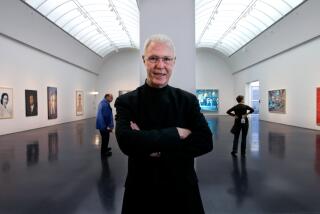POP MUSIC REVIEW : Fripp and Crafty League Show Link to Rock Base
- Share via
HUNTINGTON BEACH — Robert Fripp has worked near guitardom’s experimental fringes ever since 1969 when he debuted with his progressive rock band, King Crimson. He has collaborated with such kindred souls as Brian Eno and David Byrne and developed such innovative techniques as the tape-loop driven “Frippertronics.”
But the donnish little Englishman no longer needs to rely on tapes and synthesizers for unusual sonic effects, or on famous names for interesting collaborative efforts. Fripp has his League of Crafty Guitarists, an acoustic guitar orchestra made up of 10 students schooled in “Guitar Craft,” an approach to learning and performing that Fripp has been teaching in seminars for more than five years.
When Fripp and the League played Peppers Golden Bear Thursday night, parts of the 90-minute concert traced the abstract, modernistic sonic architecture that he and a 14-guitar version of the League created during a Southern California swing in early 1989. But for all the avant-leaning, exploratory possibilities open to this ensemble of extremely precise, well-drilled, eminently crafty guitarists, other segments of the Golden Bear concert offered some good, meaty chunks of rock ‘n’ roll, suggesting a link between Fripp’s new ensemble and his old base. While the League comported itself with the formality of a classical ensemble, the stylistic balance erased any risk that the performance would turn into a dry, academic journey into the abstruse.
At its most abstract, the League sounded like some magical clockmaker’s shop, with a wall full of pieces chiming independently, yet at intervals suggesting an ordered (if unconventional) sense of time. Sometimes only a duo, a trio or a quartet of guitarists would be playing--one or two perhaps supplying bass figures full of drive and presence, while others countered or paralleled the bass parts with clear, ringing treble tones.
However many guitars were involved, the compositions emphasized motion and propulsion, building tension, easing off a bit, then building anew. From a method involving a great deal of repetition, the League created a sense of unfolding movement and change that sustained interest.
Along with uneven structures and dissonances, the League provided glimpses of accessible, familiar pop scenery. One charging, riffing piece sounded like a revision of the “Peter Gunn” surf-rock style. Some playfully rambling, near-boogie blues turned up. Such segments lent humor to the show and gave the listener a bit of a cushion to fall back on until the next demanding piece came along.
Also serving as welcome changes of pace were periodic solo a cappella interludes by the League’s 12th member, singer Patricia Leavitt. With lyrics that alluded sometimes to romance and sometimes to the quest to attain philosophic or ethical ideals, Leavitt displayed a strong voice that ranged from flute-like smoothness to a guttural, sax-like honk. Her phrasing had a strong folk-gospel tint that recalled the likes of Joan Armatrading, Tracy Chapman and Sweet Honey in the Rock.
Fripp folded his own guitar work into the ensemble, soloing briefly on occasion but not enough to suggest that the League could be viewed simply as a backdrop for his virtuosity. Flashy technique came from all sectors of the semicircle of seated guitarists.
At one point, several players combined to create the round, broad-textured tones of a bowed cello or bass. Several times, all 11 players marched ahead with inexorable, intense unison chording--a hammering device that was used sparingly, for maximum effect. The League was equally deft in evoking the gentle motion of ripples on a placid pond--Fripp sending out the first wavering, pinging note from his spot at the end of the semicircle, to have it picked up and passed along by each guitarist in succession. A complex wave pattern emerged, then the music subsided into eloquent silence.
The show was theatrical in a strange, austere way. Fripp marched his guitar-toting troops on and off the stage in a column, instruments held vertically, like muskets. The group took long, meditative pauses from time to time, as if to gather concentration for the next musical foray. Not a word was spoken from the stage, and nobody cracked a smile until Fripp permitted himself a mild grin during final bows. The League eschewed spotlights and other stage lighting effects, performing with the house lights on.
On most nights, one would prefer performers to reach out and bring a personal dimension to a show. But the League’s absorbing concert proved that musicians also can make a strong personal statement by quietly upholding standards of detailed craftsmanship, intense focus, and a high level of musical invention.
The Golden Bear passed the League’s acoustic music test with high marks, offering excellent sound clarity.
But somebody blundered when it came to seating arrangements. About 30 people who had bought dinner packages sat at tables next to the stage. Reserving the best seats for dinner customers is standard practice in clubs that double as restaurants, but instead of filling in the space immediately behind the diners with tables and chairs, the floor was left empty, costing scores of fans the pleasure of watching Fripp and company from unusually close quarters. Ticket-holders (at $18.50 each) who could have been sitting up close were shunted to the back half of the room because they hadn’t shelled out additional money for food.
That empty floor looked ridiculous and defied the logic of good club management, which calls for allowing listeners the best possible vantage point.
More to Read
The biggest entertainment stories
Get our big stories about Hollywood, film, television, music, arts, culture and more right in your inbox as soon as they publish.
You may occasionally receive promotional content from the Los Angeles Times.










